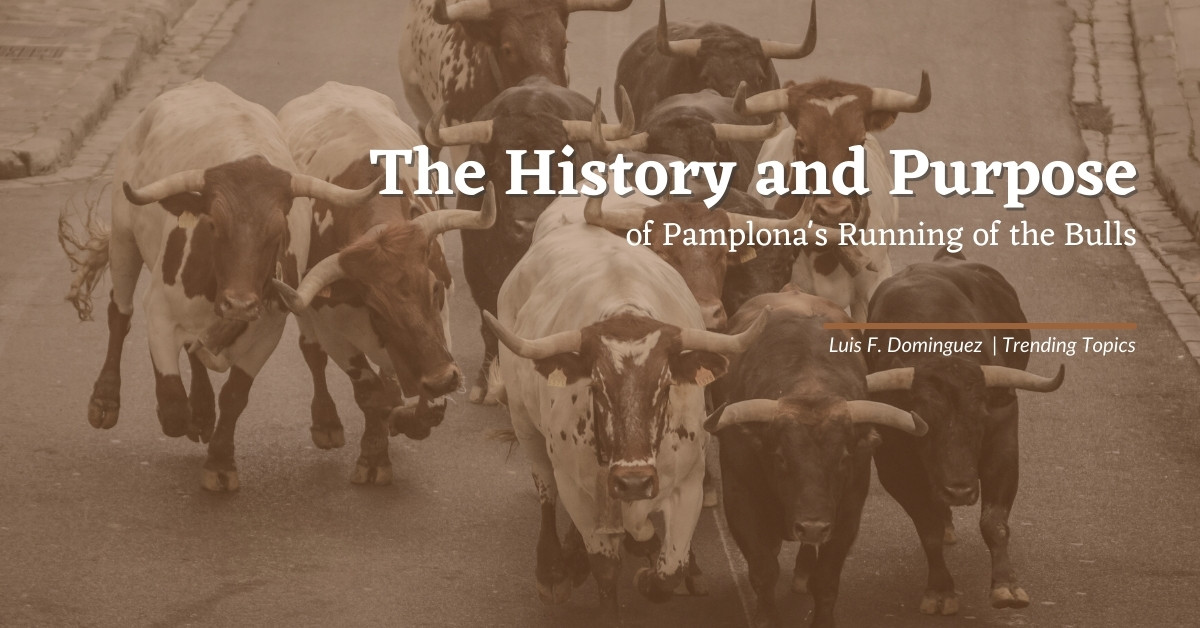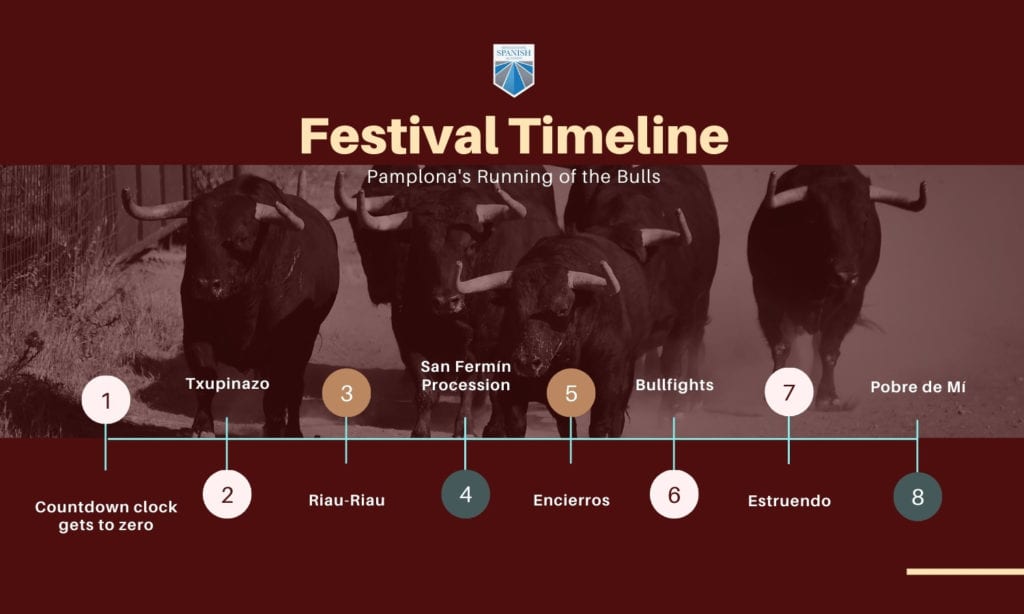
The History and Purpose of Pamplona’s Running of the Bulls
The popular running of the bulls in Pamplona is one of Spain’s most spectacular festivities. However, it’s also one of its most controversial traditions.
Since Ernest Hemingway included some of the traditions involved in the San Fermín Festival in one of his novels, Pamplona’s running of the bulls has captured the imagination of thousands of people around the world.
Keep reading to learn more about this extraordinary Spanish tradition, its history and origins, why it is so controversial, and the other traditions that give form to the famed San Fermín Festival.
Pamplona’s Running of the Bulls: What Is It?
Unless you live in a cave, odds are that you have heard that every summer, a few apparently crazy people run in front of a herd of bulls through the streets of a small Spanish city.
Where does running of the bulls take place?
That city is Pamplona, Spain and its running of the bulls is the most keynote event of one of the biggest fiestas on Earth: the San Fermín Festival.
What is the running of the bulls called in Spanish?
The word Spanish people use to refer to the running of the bulls is encierro, which literally translates as “confinement.” The word comes from the origins of the tradition. To transfer bulls from one part of the city to another, people would block streets to “confine” the bulls to controlled route.
How Long Is the Running of the Bulls?
These days, the encierro takes about two and a half minutes, which is the time that takes the bulls to run the 850 meters from its starting point at the pens of Santo Domingo to the bullring.
However, sometimes the bulls get distracted or something unexpected happens, and the encierro can take a bit longer. There have been editions when the running of the bulls has taken up to half an hour.
History and Origins
As is the case with most Spanish traditions, the Pamplona Spain running of the bulls started as a religious ceremony in the Middle Ages. In this case, the celebration was to commemorate the martyrdom of San Fermín, and it dates back to the 12th century. At this point, the celebration was strictly religious and took place in September.
In the 14th century, the local fair was held at the end of September every year, which meant that many merchants, farmers, and locals gathered together at approximately the same time as the San Fermín commemoration.
However, the weather in September isn’t the best for a fiesta in north Spain, so Pamplonenses organized themselves to change their patron saint’s feast day to July 7, which has been the official Día de San Fermín since 1591.
Different elements and traditions were added over the years, such as the Procesión de los Gigantes y Cabezudos (Procession of the Giants and Bigheads), the Chupinazo (or Txupinazo in Basque language), and the running of the bulls, among many others.
What Does Ernest Hemingway Have to Do With It?
The San Fermín Festival in Pamplona was just a traditional fiesta like those in every little town and city in Spain, with its unique features and particularities. And it would have stayed that way if not for American writer Ernest Hemingway, who in 1926 wrote the novel The Sun Also Rises—also known as Fiesta.
In his novel, the Nobel Prize winner introduced the San Fermín Festival to the world by describing what he had seen and experienced in his multiple trips to Pamplona. Hemingway’s notoriety, his notable writing style, and the unusual traditions he described made the festival world famous and put it in the spotlight for international travelers.
Controversial Tradition
Notwithstanding its fame and popularity, the running of the bulls is a controversial tradition, to say the least. Not only is it a dangerous activity for participants, with around 200 injuries a year and 15 recorded deaths since 1910, but it’s also a tradition that animal rights defenders label as “cruel” and “barbaric.”
Homeschool Spanish Academy is a language academy that explores the traditions and customs of the Spanish culture with the goal of helping our students better understand it and master its language. We objectively present the facts of the festivity and let you decide on the morality of it.
Animal Welfare Perspective
Animal rights associations such as PETA consider the running of the bulls in Pamplona during the San Fermín Festival to be “a barbaric bloodbath” that should be ended immediately.
They point out that at least 48 of the bulls running at the encierros are killed in the bullring during the festival. They describe in detail the cruelty of the Spanish bullfight tradition and protest against it.
Spanish Fans’ Perspective
While many Spanish people are against the running of the bulls in Pamplona and the bullfight tradition in general, defenders of the running of the bulls argue that it’s an ancient tradition based on the old Spanish way of life and that prohibiting it would be an intrusion on their culture.
They also point out that there are many other cases of animal cruelty, particularly the practices of a food industry that provides meat for many of the same animal rights defenders who want to cancel the festival.
San Fermín Festival: Other Traditions
Controversy aside, the San Fermines or Sanfermines, as the festival is also known, has a series of other traditions that tend to be overshadowed by the running of the bulls. Let’s get to know a few of them:
Countdown Clock
The countdown clock is one of the most recent traditions added to the festival. It counts the days, hours, minutes, and seconds left until the start of the next San Fermin Festival. When it gets to zero, the traditional txupinazo is launched.
Txupinazo
The “txupinazo,” or chupinazo in Spanish, is a rocket launched from the balcony of Pamplona’s city hall at Noon on July 6 to kickstart the celebration. The first txupinazo was launched in 1901 by two friends who wanted to start the party with a bang, and the idea was adopted by the organizers of the festival.
Riau-Riau
A traditional procession on which Pamplona’s politicians and civil servants march from city hall to the San Lorenzo church on July 6. Hundreds of locals join the political councilors to cover the 500 hundred meters that separates the buildings, singing and dancing to the rhythm of the famous Astrain Waltz.
Red Scarves
Before the chupinazo is fired, you’ll see everybody with a red scarf around their wrists or waving it in the air. Once the chupinazo is fired, all participants put the red scarves around their necks as tradition says that you can only wear it for the duration of the Sanfermines.
The origins of the red scarves are religious, just like the festival itself. Because San Fermín was a martyr who died for his beliefs, the priests dress in red on his day. That’s the reason the scarves are red.
Pobre de Mí
These laconic words mean “poor me,” and this is the name of the festival’s closing ceremony. Participants gather at Plaza Consistorial chanting the verses of the Pobre de Mí song, mourning the end of the Sanfermines.
Festival Timeline

By now you’ve got an idea of the San Fermín Festival timeline. Here’s a quick summary:
- Countdown clock gets to zero
- Txupinazo
- Riau-Riau
- San Fermín Procession
- Encierros
- Bullfights
- Estruendo
- Pobre de Mí
The San Fermín Festival’s 2020 and 2021 editions were cancelled due to the coronavirus pandemic. If you’re interested in visiting Pamplona to participate in the running of the bulls, you may start making plans for 2022, as the festival is hugely popular and after a two-year absence, a great number of visitors is expected.
Cultural Learning is also Language Learning
If you want to learn Spanish you study its grammar rules, basic vocabulary, and conjugation sets—and educate yourself on its culture. Learning about the culture of your goal language is one of the best ways to understand why the language is the way it is. For that reason, here at HSA, we aim to provide our readers and students with cultural glimpses of the different Spanish-speaking countries, such as the San Fermín Festival and the running of the bulls.
To practice your Spanish skills before you take a trip to Europe or Latin America, sign up for a free class with one of our certified and native Spanish-speaking teachers from Guatemala. (Even if you stay in the U.S., according to CNN, 41 million native Spanish speakers live in this country!) We offer flexible scheduling, tailored Spanish packages and industry-specific options for work-related learning.

Do you love Hispanic culture? Check out our latest posts!
- The Best Spanish Learning Podcasts for Kids
- 12 Contemporary Spanish Female Artists Who Will Empower You
- The History and Significance of Guatemalan Jade
- Are Bilingual Children More Likely to Experience a Speech or Language Delay?
- Top 10 Places to Visit in Guatemala City, Guatemala
- Learn About Hispanic History: Were Hispanics Slaves?
- Celebrating Culture and Joy: The Magic of Carnival in Spanish-Speaking Countries
- 15 Mouth-Watering National Dishes of Latin America
- 50 Useful Spanish Transition Words for Everyday Speech and Writing - January 30, 2025
- Master the 18 Spanish Tenses (and Take Our Cheat Sheet With You) - January 23, 2025
- A Guide to Double Negatives in Spanish - December 18, 2024







